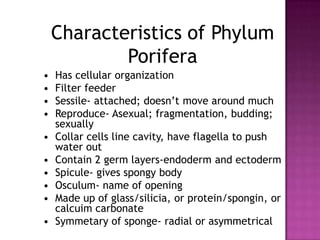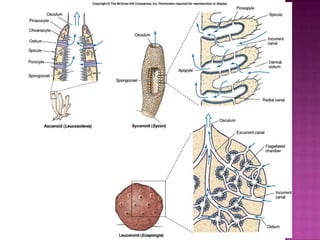Presentation of porifera
- 2. Table of Contents General description Sponge canal system Unique characteristics Systems (integument, skeletal, muscle, digestive) • Systems (respiratory, circulatory, nervous) • Systems (endocrine and reproductive) • Taxonomy • • • • – Calcispongiae – Hyalospongiae – Demospongiae
- 3. Ciri-ciri filum porifera • Tubuh umumnya asimetri (tidak beraturan) , beberapa simetri radial • Bentuk seperti vas bunga, mangkuk atau tabung • Tubuhnya berpori/ memiliki lubang-lubang kecil • Belum memiliki jaringan dan organ shg disebut parazoa • Hidup secara heterotrof (makan bakteri dan plankton) • Habitat umumnya di laut beberapa spesies hidup di air tawar. • Reproduksi secara sexual maupun asexsual
- 4. CIRI UMUM : • Berasal dar kata Porus ( Lubang kecil ) dan faro ( membawa atau mengandung ). Hewan yang tubuhnya mengandung lubang-lubang kecil atau hewan berpori-pori. • Memiliki sistim kanal atau saluran air untuk mensirkulasikan air di dalam tubuhnya. • Mengalami dua bentuk kehidupan yaitu Polip ( hidup berenang bebas terjadi pada fase larva ) dan Sesil ( hidup menetap terjadi pada fase dewasa ) • Belum memiliki organ pencernaan, Sistem saraf, dan sistem Peredaran darah. Hidup di laut,kecuali satu famili hidup di air tawar. Golongan binatang multisel primitif Jaringan terdiri dari epidermis dan sel-sel berleher (koanosit)
- 5. Multicellular • Composed of 3 layers Body with pores (ostia) – outer layer of flattened contractile cells (pinacocytes) No organs or true tissues. – inner non-living mesoglea No nervous system containing a variety of specialized Adults sessile & attached to cells substratum. – collar cells (choanocytes) which • Skeleton of calcareous capture food, etc. from water spicules, siliceous flowing through channels. spicules, spongin or a • Exhibit asymmetry or radial symmetry. combination. • All aquatic, mostly marine. • Reproduction - asexual by buds & gemmules. Sexual by eggs & sperm. • Grouped as Parazoans multicellular animals with no welldefined tissue. • They are sessile, and asymmetrical (sometimes with radial symmetry). Body organized • • • • •
- 6. Characteristics of Phylum Porifera • • • • • • • • • • Has cellular organization Filter feeder Sessile- attached; doesn’t move around much Reproduce- Asexual; fragmentation, budding; sexually Collar cells line cavity, have flagella to push water out Contain 2 germ layers-endoderm and ectoderm Spicule- gives spongy body Osculum- name of opening Made up of glass/silicia, or protein/spongin, or calcuim carbonate Symmetary of sponge- radial or asymmetrical
- 7. Some unique characteristics • • • • • Spicules Choanocytes (collar cells) No true tissue Pores Body plans (asconoid, syconoid, leuconoid)
- 8. Sponge Canal Systems • The body plans or structures are based on complexity of water-canal and skeletal system • Asconoid – Choanocytes line the spongocoel • Syconoid – Choanocytes are in radial canals off spongocoel • Leuconoid – Choanocytes are in chambers off of the radial canals.
- 9. Sistem Sirkulasi Air • Dapat dibedakan menjadi 3 tipe : 1. Tipe Ascon. Air masuk Ostium – Spongosol- Osculum Contoh ; Leucosolenia 2. Tipe Sycon / Scypa. Air masuk Ostium – Saluran bercabang cabangSpongosol - Osculum. Contoh : Scypa. 3. Tipe Leucon / Rhagon. Air masuk Ostium – Saluran bercabang cabang – Rongga -Osculum. Contoh : Spongila.
- 14. Fig. 12.5 14
- 15. Struktur morfologi & anatomi • Berbentuk seperti jambangan ,Piala, Terompet, dan ada yang bercabang-cabang seperti tumbuhan. • Pada bagian tengah tubuh ada ruang yang disebut Spongosol. Yang meupakan saluran air. • Pada bagian ujung atas ada lubang besar yang disebut Osculum.
- 20. Syconoid Sponge Osculum Incurrent Canal Spongocoel Radial Canal Ostium Choanocytes 20
- 22. Syconoid Sponge Scypha (Grantia) xs Spongocoel Radial Canal Choanocytes Incurrent Canal Ostium 22
- 23. Leuconoid Sponge Osculum Excurrent canal Incurrent pore Incurrent canal Choanocyte chamber 23
- 24. STRUKTUR ANATOMI
- 26. Internal Structure of the Sponge
- 30. LAPISAN PENYUSUN DINDING TUBUH 1.Lapisan terluar (Efidermis). - Tersusun oleh sel-sel Efitelium pipih yang disebut Pinakosit - Beberapa sel Pinakosit membentuk lubang kecil disebut Ostium - Saluran lubang-lubang kecil dilapisi oleh Porosit. Yang berfungsi sebagai pengendali membuka dan menutupnya Ostium. 2. Lapisan Mesoglea ( berupa gelatin) Merupakan lapisan pembatas antara lapisan dalam dan luar yang mengandung : a. Sel Amoebosit berfungsi untuk mengangkut zat makanan dan zat sisa metabolisma dari sel satu ke sel lainnya. b. Sel Skleroblas yang berfungsi untuk membentuk Spikula ( duri ) sebagai penguat dinding yang lunak. Yang tersusun dari Zat Kapur, Zat Kersik dan Spongin ( Protei ) 3. Lapisan Dalam ( Endodermis ) Lapisan ini terdiri dari Sel Leher ( Koanosit ) berflagel yang berfungsi untuk mencerna makanan.
- 31. 31
- 32. Spicule • Skeleton of sponge – Calcium carbonate – Silicon – Collagen 32
- 35. Archeocyte • Amoeboid cells • Receive food from choanocytes • Differentiate into other cell types 35
- 37. Mesenchyme (Mesoglea or Mesohyl) • Gelantinous matrix 37
- 38. Pinococyte • Outer surface of sponge • Contractile 38
- 39. Choanocyte • Flagellated cells • One end in mesnchyme • Flagella creates water currents • Collar traps food • Passes food to archeocyte 39
- 43. Porocyte • Forms a pore 43
- 44. Pinococyte • Outer surface of sponge • Contractile 44
- 45. Physiology • • • • Large sponges filter 1500 liters/day Choanocytes phagocytize Archeocytes digest No respiratory, excretory or nervous systems
- 46. Porifera Systems • Integumentary – Pinacocytes - thin flat layer of T-shaped cells • Skeletal – Spicules and spongin (forms of collagen) • Muscle – Movement cellular by flagella and pseudopodia • Digestive – Intracellular; use choanocytes to trap
- 47. Porifera Systems • Excretory – Marine are isotonic, freshwater forms use contractile vacuoles. • Respiratory – diffusion by individual cells • Circulatory – Choanocytes create current, ameboid cells transport food • Nervous – Cell irritability shown by individual cells
- 48. Porifera Systems • Endocrine – endocrine like chemical present within individual cells • Reproductive – External fertilization, or sperm brought in choanocytes and fertilization occurs in chambers. – Asexual: regenerate whole sponge from a few spicules, choanocytes and amoeboid cells. – Gemmules in freshwater sponge (a few marine ones)
- 49. Nutrition/Digestive System Sponges DO NOT have organs because of their lack of tissues. Instead they use a specialized cells that take the job of tissues. Digestion is also intracellular •The main diet of sponges are bacteria and small food particles that are carried by water when it enters the sponge •Water enters the Porifera through its pores (called ostium, or ostia, which is plural) •Flagella lined up in the center cavity (called the Spongocoel) beat to create a current in the water that enters to move it up and down the cavity •Water and nutrients are absorbed by the collar cells, which are also lined up in the cavity •The collar cells give the nutrients to the choanocytes (choanocytes are attached to the collar cells) •The nutrients are transported by the choanocytes to the archaeocytes, which are attached to the choanocytes •The archaeocytes transport the nutrients around the sponge
- 50. Excretory System Sponges only produce carbon dioxide as waste. Waste exits through the Osculum (opening above center cavity) Carbon dioxide is dispelled through water that passes through the cells.
- 51. Respiration Oxygen from water enters through the ostia (pores) and is absorbed by the collar cells, Which are then given to the choanocytes. The choanocytes transport the nutrients to the archaeocytes, where they transport oxygen to other body parts.
- 52. Nervous System A sponge does NOT have any true nervous system Some sponges react in response to touch or change in pH level, but only slightly
- 53. Locomotion Sponges BARELY move through body contractions. Sponge larvae can swim, however adults are attached to rocks and can move an average of 4 mm a day.
- 54. Reproduction Sponges have two methods of reproduction, sexual and asexual. In sexual reproduction the Asexual reproduction in sponges male sponge releases a gamete usually involve budding. that travels through the water A bud forms at the side of the until it arrives to a female parents sponge and develops until sponge of the same species. it separates to form a daughter The female sponge then takes sponge. the gamete into its body where it fertilizes an egg. Sponges can also be hermaphrodites which mean that they have both genitals of the male and female.
- 55. Sistem Repruduksi Porifera • Repruduksi Porifera berlangaung secara : 1. Secara Asexual. a. Pembentukan Kuncup. b. Pembentukan butir benih ( Gemule ) terjadi apabila keadaan lingkungan tidak menguntungkan. 2. Secara Sexual. a. Terjadi melalui persatuan Sperma dan Ovum. b. Bersifat Hermaprodit yaitu Ovum dan Sperma diproduksi olehsatu induk yang sama. Akan tetapi tidak bisa langsung membuahi
- 56. REPRODUKSI VEGETATIF : 1. Budding 2. Fragmentation Micropyle 3. Gemmule formationSpicule -survive freezing 56
- 60. 1. Monoecious. Both male and female 2. Sperm and egg derived fromchoanocytes 3. Ciliated larvaSwim to new location
- 61. Habitat All sponges live in aquatic habitats under water. Most live in salt water environments, but there are some sponges that live in fresh water environments. A real sponge in its natural salt water environment A fake sponge in his underwater environment
- 62. Atas dasar susunan rangkanya porifera dapat di bagi menjadi 3 kelas yaitu: 1. Calcarea Mempunyai spikula dari kapur. Contoh: Leucosolenia. Grantia. Scypha. Sycon dan Clathrina 2. Hexactinellida. Mempunyai spikula dari silikat/Kresik Contoh: Euplectella. Pheronema 3. Demospongiae. Mempunyai spikula silikatdan serabut spongin,atau hanya spongin saja. Contoh: Euspongia. Spongilla. Callyspongia dan Phyllospongia.
- 63. Porifera Taxonomy • Class: Calcispongiae /calcarea – Scypha (Grantia or Sycon) – Leucosolenia Hyalospongiae /hexaktinellida • Class: – Euplectella • Class: Demospongiae (dem-o-spon-ge-a) – Euspongia (Spongia) – Spongilla • Class: Sclerospongiae (skler-o--spon-ge-
- 64. There are three types of Porifera based on their interior structure – Hexactinellids – Known as Glass sponges, these are considered the earliest form of sponges Calceria – Sponges that adapt to warm and tropical climates Desmospongia – These are the most common sponges found. You may find them almost anywhere
- 65. Taxonomy Class Calcispongiae • Spicules of calcium carbonate (all three canal systems present in class) Leucosolenia (stained) Grantia (Scypha) Spicules
- 66. Class Hyalospongiae • Six-rayed silicon spicules Euplectella (Venus’ flower basket)
- 67. • Glass sponges; characterized by siliceous spicules consisting of six rays intersecting at right angles • Widely viewed as an early branch within the Porifera
- 68. Class Demospongiae • Presence of spongin, or silicon spicules (that are not six-rayed) or both . Euspongia (Spongia) Spongilla
- 70. You will never find a porifera with the name of Spongebob Squarepants. However, These are some examples of REAL sponges. Demospon giae Hexactinelli da Calcarea Xestosponia Asbestoplum






































































